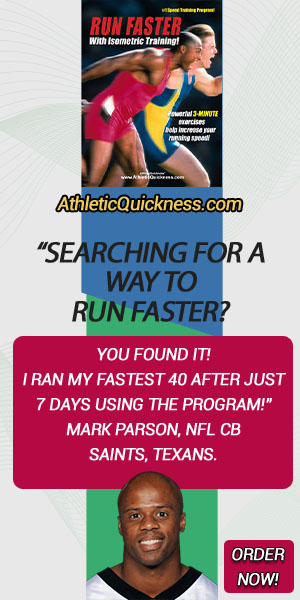Resistance Band Exercises – A very effective way to develop speed and quickness when you follow these 3 Rules!
The resistance band is an excellent athletic training tool that, when used properly, can significantly enhance your training experience and accelerate your performance, literally, to new heights.

Figure 1. The resistance band, or, exercise band, tied in a loop ready for workout
Accelerating your performance and increasing your athletic speed is what every athlete desires. And within these seemingly unassuming and flexible strips of rubber lies the one dynamic property that every athlete will want to harness to help them accomplish this.
The physical property within the resistance band that I am referring to is known as a Spring Constant. The spring constant is the term used to define how stiff, or lack thereof, a given resistance band, or for that matter, a rubber band is when you attempt to stretch it.
A resistance band with a high spring constant will be harder to stretch than one with a low spring constant. You, as an athlete, more than likely have already encountered this at some point in your training by observing that some exercise bands are harder to stretch than others. This difference is directly related to the spring constant found within the band.
You may have also observed that these resistance bands come in many different colors. This is done for a reason as the companies who make them usually do so in a way to help athletes quickly identify the strength (the spring constant), within a given band.
Typically speaking, the lighter the color of the band, the weaker, less stiff, or lower the spring constant is. Likewise, the darker the color of the band, the stronger, the stiffer, or higher the spring constant is.
For those who would like a slightly more technical explanation, the term “Spring Constant” can be applied to anything with a linear relationship between force and displacement. It would be dimensioned in something like N/cm or lb/in. You could even call it the Elasticity Constant if you don’t like term spring constant.
But enough of the technical stuff; you’re here because you want to get faster, so let’s move on to figuring out the best way to use these resistance bands to turbo-boost your workouts.
3 Rules on How an Athlete Should Use a Resistance Band to Get Faster.
While there is probably no wrong way to use a resistance band, some ways might be preferred more than others. And from my experience, there is really only one that I would recommend using them to any athlete who hopes to get quicker and perform with more power. The way I recommend can best be described, or broken down, into three rules to follow while using them.
Rule #1: the first thing you want to do is make sure you are using a band that can withstand the level of resistance that you are going to stretch it.
What I mean by this is, if you are using a relatively weak resistance band and you find yourself stretching it to a point where it can’t be stretched any further, and it feels like it might break, you will no longer be taking advantage of the elastic stretch properties of the band when it is in this position. Instead, you will have neutralized them and will have essentially turned your exercise band into a static cable, or rope, incapable of returning any elastic force back into your muscles.
So, the first key to maximizing your performance with a resistance band is to make sure whatever position your find yourself in while using it, the band is still able to stretch a little further.
If you can just remember this first simple little rule, then you will at least assure yourself that the band is doing what is meant to do, and that is, training your muscles with the dynamic force built in to it. This will in turn help to stimulate new muscle growth by creating new neuro-pathways (muscle memories of new contraction patterns) and improve your strength and coordination in the process.
Rule #2: The second thing you want to make sure of is that you are giving reasonably good, if not close to, maximum effort while using the bands.
All of what was previously mentioned will do you know good if you are a really strong and muscular individual who can press 315 lbs. and you are working out with the weakest band in the gym. If you do, your muscles won’t be able to appreciate the level of dynamic force necessary within the bands to stimulate any growth.
So, whenever you incorporate exercise bands in to your workouts, make sure you are giving good effort with them. Along with this, make absolutely certain that the exercise bands you are using have enough resistance in them to withstand your peak effort levels without ‘stretching them to their max’.
If it is not possible to locate an exercise band with a high enough resistance to counter your level of strength, then you can easily use two or more of them together, at the same time, to increase the overall resistance. See Figure 2.

Figure 2. Using two resistance bands to increase the resistance.
Actually, this is the preferred method of increasing the resistance to meet the strength demands in your muscles that I personally recommend. So, instead of trying to find the strongest bands around, it may be more practical to combine as many of the weaker ones together as necessary to raise the resistance.
In fact, I have found that the weaker bands have a smoother stretch in them, generally speaking, and it makes for using multiple ones together a dynamic training experience.
But however you choose to increase the level of resistance in your bands to match up with your effort level, still be mindful of Rule #1 in the process which states that your band(s) should always be able to stretch a little farther when you do. If you can master these simple little rules, then you’re ready for Rule #3.
Rule #3. Maintain peak effort in your muscles long enough for strength gains to occur.
Okay, you know the drill; you walk in to a gym and see someone using an exercise band. Perhaps they are stepping on one end with their foot and grabbing the other end with their hand. And now they are performing a biceps curl motion with it, up and down, again and again. What’s wrong with this?
On the surface, nothing is wrong since all exercises have value. But, you have to know what to expect from any exercise to see if it will help you reach your specific goals.
So, in this particular example, this is exactly what I would recommend to someone who may be suffering with an injury to either their elbow joint or shoulder capsule as well as for any tear in their biceps or rotator cuff.
But, for an athlete looking to build strength and speed in their muscles, this is not what I would recommend to them. Here’s the reason why:
You already know that the resistance in the band increases based on the length it is stretched. As this pertains to exercising with them, it usually means the beginning of an exercise will be much easier to do than the end. This is because the band starts off with very little stretch and ends with considerably more.
Add to this the fact that as soon as you reach peak muscle contraction for an exercise, you immediately return back to the starting position where the band is weak again.
So, by using resistance bands with a repetitious strategy (up and down, forward and back, etc.), you won’t be engaging your muscles long enough at their peak effort levels for there to be any real appreciable gains in them.
This is probably the number one reason why many athletes invest very little time and effort in using them and, understandably so.
The ideal way to use them to build speed and strength in your muscles is as follows: get the muscle(s) you are looking to train in some flexed position. Any position within the muscle’s and joint’s range of motion will work, but typically you will want to focus on the position where it is the weakest.
Then, make sure the resistance band(s) that you are using are already stretched far enough at this position to really challenge those muscles. This may require you to adjust your positioning a little to get the band stretched far enough. And finally, you will want to hold this position steady (no repetitious movement) for at least 10-15 seconds.
This is an isometric contraction using a resistance band and will force you to maintain peak effort in your muscles long enough for speed and strength gains to occur.
The really interesting thing about training your muscles this way is that if you are giving good effort during this holding period, eventually your muscles will start to weaken.
But when you try to maintain the isometric contraction in this weakened state, something new happens.
A whole new dynamic in muscle recruitment takes place, perhaps for the first time ever within those muscles. And new muscle recruitment patterns mean new levels of athletic performance which is exactly what you want. You can learn more about this by visiting our isometric training page.
For now, let’s review what we talked about regarding the resistance bands. They are excellent athletic training devices that have a unique property in them called a spring constant, or, elastic constant. You can immediately tell the difference between holding a stretched band in one hand and a weight in the other. The stretched band feels more ‘alive’ when compared to the static weight. This dynamic force can help you become a faster and stronger athlete if you know how to tap in to it.
The best way to use these bands is with an isometric training strategy. When holding any position with your arms or legs, you will want to use good effort. Anywhere between 70-80% of your maximum strength is a good amount. To know if you are using this level of force, you should feel you need to take a rest from the isometric hold position around the ten second mark.
You can use as many exercise bands together to make an exercise challenging for you. And regardless of how many bands you are using, you want to make sure the bands are still capable of stretching a little further when engaging your peak effort levels with them.
If you can learn to incorporate these rules into your resistance band training, there’s no telling how dynamic of an athlete you can become.



